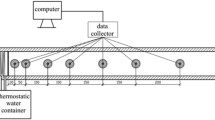Abstract
The mathematical model describing unsteady thermal operating conditions of ground-source heat-pump (GSHP) heat supply systems that takes into account porous moisture condensation/evaporation processes and that is laid down in the basis of the corresponding block of the INSOLAR.GSHP.12 software system is considered. The results of numerical and laboratory experiments confirming that the GSHP performance efficiency depends essentially on the phase transition processes of moisture contained in the soil strata porous space are presented. The problem of correctly taking into account the heat of porous moisture condensation/evaporation phenomena in simulating the thermal processes occurring in the soil strata surrounding GSHP thermal wells is considered. A mathematical description of porous moisture condensation/evaporation processes for a vertical thermal well in the cylindrical coordinate system is given. A numerical experiment on estimating the effect the porous moisture condensation/evaporation processes have on the soil thermal conditions was carried out after the mathematical model had been implemented in a software block. The presented results obtained from the performed numerical experiment show that the temperature levels of soil adjacent to the thermal well determined with and without taking the heat of porous moisture condensation processes may differ from each other by more than 3°C. The results from experimentally approbating the application of a so-called effective soil thermal conductivity coefficient that takes into account the latent heat of porous moisture phase transitions in soil in modeling the GSHP thermal operating conditions are presented. The results of the performed experiments show that porous moisture phase transitions may have a very significant influence on the effective thermal conductivity of soil. The effective thermal conductivity values of soil may differ from each other by several times depending on the soil system operating conditions.
Similar content being viewed by others
References
G. P. Vasilyev, N. V. Peskov, V. A. Lichman, V. F. Gornov, and M. V. Kolesova, “Simulating the thermal operating conditions in the thermal wells of ground-source heat-pump heat supply systems. Part I: Accounting the porous moisture freezing processes in soil,” Therm. Eng. 62 (8), (2015), DOI: 10.1134/S0040363615080081
J. W. Lund, D. H. Freeston, and T. L. Boyd, “Direct utilization of geothermal energy 2010 worldwide review,” Geothermics, No. 40, 159–180 (2011).
G. P. Vasil’ev, “Operating experience with geothermal heat-pump heat-supplying systems and the technical aspects of integrating them rationally in the energy balance of Russia,” Therm. Eng. 51 (6), 459 (2004).
G. P. Vasil’ev, “Results of full-scale investigations of the thermal operating conditions of an experimental energyefficient house,” Stroit. Mater., Oborud., Tekhnol. XXI Veka, No. 6, 3–5 (2002).
S. C. Gupta, “The classical Stefan problem: basic concepts, modeling and analysis,” in North Holland Series in Applied Mathematics and Mechanics (JAI Press, 2003), http://elsevier.com.
H. Yang, P. Cui, and Z. Fang, “Vertical-borehole ground-coupled heat pumps: a review of models and systems,” Applied Energy, No. 87, 16–27 (2010).
L. Lamarche, S. Kajl, and B. Beauchamp, “A review of methods to evaluate borehole thermal resistances in geothermal heat-pump systems,” Geothermics, No. 39, 187–200 (2010).
M. G. Tarabanov, V. D. Korkin, and V. F. Sergeev, Humid Air: A Handbook (NP AVOK, Moscow, 2004) [in Russian].
Author information
Authors and Affiliations
Additional information
Original Russian Text © G.P. Vasilyev, N.V. Peskov, V.A. Lichman, V.F. Gornov, M.V. Kolesova, 2015, published in Teploenergetika.
Rights and permissions
About this article
Cite this article
Vasilyev, G.P., Peskov, N.V., Lichman, V.A. et al. Simulating the thermal operating conditions in the thermal wells of ground-source heat-pump heat supply systems. Part II: Consideration of porous moisture phase transitions in soil. Therm. Eng. 62, 751–756 (2015). https://doi.org/10.1134/S0040601515100109
Published:
Issue Date:
DOI: https://doi.org/10.1134/S0040601515100109




